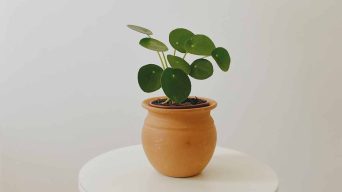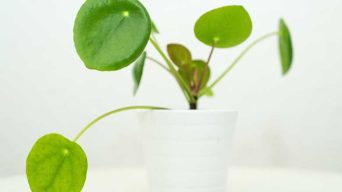Pilea plants, also known as the Chinese money plant or the ufo plant, are a popular choice for indoor plants.
They’re easy to care for and have beautiful, round leaves. But sometimes, they can get leggy.
Leggy means that the plant is growing too tall and thin and the leaves are spaced far apart. This doesn’t look very nice and can weaken your plant. This often happens if the plant is not getting enough light.
Pilea plants need bright indirect light to grow well. If your plant is in a dark room or isn’t getting enough light, it will start to stretch out and become leggy.
If your pilea plant has become leggy, don’t worry! There are a few easy things you can do to fix it.
In this article, you’ll find everything you need to know about leggy pilea plants and how to address it.
What Causes a Pilea Plant to Become Leggy?
There are a few reasons why your pilea plant might become leggy. The most common cause is that the plant is not getting enough light. If the plant does not receive enough light, it will grow longer stems in an attempt to reach the light.
Another common reason for leggy growth is overfertilization. If you fertilize your plant too often or with too much fertilizer, it can cause the plant to become leggy.
This is because the plant grows too quickly and doesn’t have time to develop strong, sturdy stems.
How To Tell If Your Pilea Plant is Leggy
A few signs will help you tell if your plant is leggy.
The most common signs are:
The Plant Has Long, Thin Stems
If the plant’s stems are longer and thinner than usual, it is likely leggy. This is because the plant is stretching to reach the light.
When the stems are long and thin, they are not as strong and can easily break.
The Plant Has Few Leaves
If the plant has fewer leaves than it usually does, this is another sign that it is leggy. The plant uses all its energy to grow longer stems instead of developing new leaves.
A healthy pilea plant should have lots of green, vibrant leaves.
The Leaves Are Smaller Than Normal
If the plant’s leaves are smaller than normal, leggy growth is another sign. This is because the plant is not receiving enough nutrients and is struggling to survive.
When a plant is leggy, it cannot produce the same number of leaves as a healthy plant.
The Plant Looks Unhealthy
If the plant looks unhealthy, with pale leaves and weak stems, it is likely leggy. This is because the plant is not receiving enough nutrients or light, which can cause it to become unhealthy.
How To Fix a Leggy Pilea Plant
Pilea plants are easy to care for, and there are a few simple things you can do to fix a leggy plant.
Here are a few tips:
Move Your Pilea Plant to a Bright Location
If your plant is not receiving enough light, the best thing you can do is move it to a brighter location. Pilea plants need bright indirect light to thrive.
If possible, place the plant near a window where it will receive lots of natural light.
An east- or west-facing window is ideal. This will give the plant the bright light it needs without exposing it to direct sunlight, which can be harmful.
If your pilea plant is placed in a room with little natural light, you may need to supplement it with artificial lighting.
You can do this by placing the plant under a grow light or Fluorescent light for 12-14 hours daily.
This will give the plant the light to grow strong and healthy.
Prune Your Pilea Plant
You can fix your plant by pruning the stems if it is leggy. This will encourage the plant to grow new, shorter, more robust, healthier stems.
Pruning is also an excellent way to encourage the plant to produce new leaves.
To prune your pilea plant, cut the stems back to the desired length with scissors.
You can remove any yellow or dead leaves, as these will not regrow.
When pruning your plant, make clean cuts at a 45-degree angle. This will help the plant heal quickly and prevent disease.
Cut back the stems until they are about 6 inches long. This will encourage the plant to produce new growth.
Cut Back on Fertilizer
If you think your plant is leggy due to overfertilization, the best thing you can do is cut back on fertilizer.
Pilea plants only need to be fertilized once every two weeks during the growing season.
If you are using a liquid fertilizer, be sure to dilute it to half-strength.
This will prevent the plant from getting too much nitrogen, which can cause leggy growth.
You can also try using a slow-release fertilizer. This type of fertilizer is released slowly into the soil and won’t shock the plant with too much nitrogen all at once.
Repot Your Pilea Plant
Pilea plants are fast-growing and must be repotted every year or two. When repotting, use a pot that is only one size larger than the previous pot.
This will prevent the Pilea plant from becoming root-bound, which can stunt its growth.
When repotting your plant, be sure to use fresh soil. This will give the plant the nutrients it needs to grow strong and healthy.
Add a small amount of perlite or sand to the potting mix. This will help improve drainage and prevent the plant from becoming waterlogged.
Pilea plants are not picky about their potting soil but need it to be well-draining.
How To Prevent a Leggy Pilea Plant
The best way to prevent a leggy plant is to give it the proper care from the start.
Here are a few tips:
Make Sure Your Plant Is Getting Enough Light
Pilea plants need bright, indirect sunlight to thrive.
They need at least 4 hours of bright light daily, but more is better.
If possible, place the plant near a window where it will receive lots of natural light.
However, keep the plant out of direct sunlight, which can be harmful.
You can place the plant near an east- or west-facing window for the best results.
If your plant is outdoors, ensure it doesn’t get direct light during the hottest part of the day.
This will prevent the plant from getting too much heat, which can damage its leaves.
If your plant is in a room with little natural light, you may need to supplement it with artificial lighting.
Turn Your Plant Regularly
Pilea plants grow best when they are turned regularly. This ensures that all sides of the plant get an equal amount of light.
Turn the plant a quarter turn every week or so.
You can also move the plant around your house or office to ensure it gets enough light from different angles.
Prune Your Plant Regularly
Pruning your pilea plant will help to encourage new growth and prevent the plant from becoming leggy.
Be sure to prune away any dead or dying leaves and stems longer than you want them to be.
Pileas can be pruned with sharp shears or scissors.
Just sterilize the blades before you use them on your plant.
This will prevent the spread of disease.
Don’t OverFertilize Your Plant
Fertilizing your plant is essential, but you don’t want to overdo it.
Too much fertilizer can do more harm than good.
Stick to a light fertilization schedule, and only fertilize your plant when it is actively growing.
A good rule of thumb is to fertilize during the growing season every other week.
Be sure to use a light fertilizer that is specifically designed for houseplants.
You can add some organic matter to your plant’s soil, such as compost or worm castings.
This will give the plant the nutrients it needs without being too harsh.
Water Your Plant Properly
Pilea plants must be watered regularly, but you don’t want to overdo it.
Allow the soil to dry out slightly between waterings.
Water the plant thoroughly, and then allow the excess water to drain away.
Never leave your plant sitting in water, as this can lead to rotting roots.
If you are unsure whether your plant needs water, stick your finger into the soil.
If it feels dry a few inches below the surface, it’s time to water the plant.
Otherwise, wait a few more days and check again.
Final Thoughts
The best way to prevent a leggy plant is to keep it healthy.
When a plant is healthy, it will produce more chlorophyll and be able to photosynthesize better. This means the plant will have more energy to grow strong roots and stems.
If you already have a leggy plant, don’t despair! There are a few easy ways to fix it.
First, try pruning the plant. This will encourage the plant to produce new growth. Y
ou can also try moving the plant to a brighter location. This will help the plant produce more chlorophyll and become healthier overall.
With some care, you can have a healthy and thriving pilea plant that is the perfect addition to your home!







